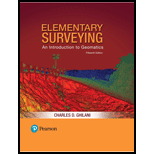
Elementary Surveying: An Introduction To Geomatics (15th Edition)
15th Edition
ISBN: 9780134604657
Author: Charles D. Ghilani
Publisher: PEARSON
expand_more
expand_more
format_list_bulleted
Concept explainers
Textbook Question
Chapter 1, Problem 1.1P
List 10 uses. for
Expert Solution & Answer
To determine
The list of ten uses for surveying in areas other than land surveying.
Explanation of Solution
The uses of surveying in areas other than land surveying are as follows
- Topographic surveys: A topographic survey is used to create maps of any location or areas by determining the elevations of all the natural as well as artificial features.
- Cadastral surveys: A cadastral survey is used to establish the property lines.
- Hydrographic surveys: The hydrographic surveying is also known as underwater surveying used to determine the depth of the water bodies, for determining and updating the nautical data which is used in navigating the oceans, and investigation of the marine environment.
- Astronomical surveys: Astronomical surveying is used to create an image of maps of celestial bodies and for determining the position of stars and planets.
- Aerial surveys: Aerial surveying is used to create the maps or images of any location by using the high-quality cameras fixed at the bottom of airplanes, helicopters or any other aerial bodies.
- Mine surveys: Mine surveying is done to determine the natural resources such as minerals and energy resources below the ground at greater depths.
- Satellite surveys: Satellite surveying is used to determine the position and altitude of any point with the help of satellites revolving around the Earth. For example, the GPS (Global Positioning System).
- Alignment surveys: Alignment surveying is used to create the maps and plans of linear projects. For example, railway, highways, sewer and pipelines and tunneling.
- Remote sensing: Remote sensing is the technique of determining the information of any geographical area by sensing the reflected relations using high-power sensing devices.
- Geographical information systems (GIS): The GIS is a computer system designed to collect, store, manipulate, and analyze the geographic data. This is done to create GIS-based maps. For example, google maps.
Conclusion:
There are many uses of surveying which are listed above.
Want to see more full solutions like this?
Subscribe now to access step-by-step solutions to millions of textbook problems written by subject matter experts!
schedule07:37
Students have asked these similar questions
Consider the specifications for an asphaltic concrete mixture and the results of a sieve analysis below.
Coarse aggregates:
Fine aggregates:
Filler:
60%
35%
5%
Percent of Weight of Aggregate or Filler
Passing
Sieve
Designation
Retained on
Sieve
Designation
Coarse
Aggregate
Fine
Aggregate
Mineral
Filler
3/4 in. (19 mm)
1/2 in.
6
1/2 in. (12.5 mm)
3/8 in.
15
3/8 in. (9.5 mm)
No. 4
50
-
No. 4 (4.75 mm)
No. 10
20
1
No. 10 (2 mm)
No. 40 (0.425 mm)
No. 40
9
35
-
No. 80
31
40
No. 80 (0.180 mm)
No. 200 (0.075 mm)
Total
No. 200
-
33
-
-
25
35
100
100
100
Determine the proportion of different aggregates to obtain the required gradation.
Percent of Total Weight of Mixture
Passing
Sieve
Designation
Retained on
Sieve
Designation
Coarse
Aggregate
Fine
Aggregate
3/4 in. (19 mm)
1/2 in. (12.5 mm)
3/8 in. (9.5 mm)
1/2 in.
3/8 in.
No. 4
No. 4 (4.75 mm)
No. 10
No. 10 (2 mm)
No. 40
No. 40 (0.425 mm)
No. 80
No. 80 (0.180 mm)
No. 200
No. 200 (0.075 mm)
Total
Need Help?
Read It
Mineral
Filler
Total
100
Results obtained from laboratory tests on a sample of RC-250 asphalt cement are given. Determine whether the properties of this material meet the Asphalt Institute specifications for this type of material; if not, note the differences. (For each specification, enter the minimum acceptab
value in the same units as used in the test results.)
• Kinematic viscosity at 140°F (60°C) = 230 centistokes
• Flash point (Tagliabue open cup) = 89°F
• Distillation test where distillate percent by volume of total distillate to 680°F (360ºC)
• To 437°F (225°C) = 27%
• To 500°F (260°C) = 69%
• To 600°F (316°C) = 72%
• Residue from distillation to 680°F (360°C) by volume percentage of sample by difference
• Tests on Residue from Distillation:
• Ductility at 77°F (25°C) = 92 cm
• Absolute viscosity at 140°F (60°C) = 620 poises
⚫ Solubility = 90%
Property
Kinematic Viscosity
=
74%
Specification
Test Results
Were Specifications Met?
centistokes
230 centistokes
---Select--- ✓
Flash Point
°F
89°F…
Problem 2
Two machines produce rivets for a factory job. The number of sub-standard rivets per hour by the two
machines are random variables, denoted by X1 and X2. The bivariate PMF of X1 and X2, Px,x,(x1,x2), is
given in the table below.
X2=0
X2=1
X2=2
X2=3
X₁-0
0.07
0.05
0.02
0.01
X₁ =1
0.05
0.16
0.12
0.02
X₁ =2
0.02
0.12
0.17
0.05
X₁ =3
0.01
0.01
0.05
0.07
Chapter 1 Solutions
Elementary Surveying: An Introduction To Geomatics (15th Edition)
Additional Engineering Textbook Solutions
Find more solutions based on key concepts
Even though a binary file is not a text file, it can contain embedded text. To find out if this is the case, wr...
Java: An Introduction to Problem Solving and Programming (8th Edition)
Explain the term cursor.
Database Concepts (8th Edition)
Write a for loop that displays the following set of numbers: 0, 10, 20, 30, 40, 50 . . . 1000
Starting Out with Python (4th Edition)
Comprehension Check 8-17
A motor with a power of 100 watts [W] is connected to a flywheel. How long, in units o...
Thinking Like an Engineer: An Active Learning Approach (4th Edition)
Porter’s competitive forces model: The model is used to provide a general view about the firms, the competitors...
Management Information Systems: Managing The Digital Firm (16th Edition)
Knowledge Booster
Learn more about
Need a deep-dive on the concept behind this application? Look no further. Learn more about this topic, civil-engineering and related others by exploring similar questions and additional content below.Similar questions
- please helparrow_forwardAS Q1/ The specific gravity of the soil is 1.41 percentage of water content by weight at field capacity and wilting point are 15% and 7% respectively calculate the equivalent moisture content as equivalent depth for 1.2m root zone : 1. at permanent wilting point 2. at field capacity 3. for ready available waterarrow_forwardQuestion 6 The following figure shows peak-hour volumes for an intersection. Using Webster's method, determine a suitable signal timing for the intersection using the four-phase system shown below. Use an amber interval of 3 seconds and the saturation flow given in the table. O 100 O Phase Lime Group Saturation Flow A e 1615-> 370 3700 B 1615 1615 3700 1615 3700arrow_forward
- PHF-0.91 Pedestrian volume is negligible. Question 7 A parking area with 60 bays has an initial count of 35 vehicles. The in-out survey data for 10-minute intervals is as per the table below. Complete the table, calculate the accumulation, occupancy (%), and parking load (veh.hrs) for each interval. Time (min) In Out Accumulation Occupancy Parking load (%) 0 3 10 2 4 20 1 1 30 1 3 40 1 6 50 1 4 60arrow_forwardQ3/ The following data represent the water depth in the soil of equal areas for specified field. Calculate the uniformity coefficient, efficiency and adequacy of irrigation. Net needed irrigation depth =75 mm (78-04, 79, 88, 85.21, 76,82)arrow_forwardA (A) Q1/ It is required to apply a net depth of 120mm to a total area of 60 ha. The applied discharge is continuously 180 L/s. What must be the time of irrigation? Assume the application efficiency 85%. а Eas 85 0% tarrow_forward
- The following figure is a flexible pavement system with the resilient moduli layer coefficients and drainage coefficients as shown. If the predicted ESAL = 6x106, Reliability, R = 99%, Standard Deviation (So) = 0.45, and APSI = 2.5, select thicknesses D1, D2, and D3 in accordance with the AASHTO Guide for Design of Pavement Structures. E₁ = 400, 000 psi; a₁ = 0.42, Thickness = D₁ E₂=30,000 psi; a₂= 0.14, m₂ = 1.2; Thickness = Dz E=11,000 psi; a=0.08, m3 = 1.2; Thickness = D3 MR= 5,700 psiarrow_forwardDiagramtically show the placement, size, and spacing of temperature steels, dowel bars and tie bars in rigid pavements. Also mention their puproses in rigid pavements.arrow_forwardA six-lane concrete roadway is being designed for a metropolitan area. This roadway will be constructed on a subgrade with an effective modulus of subgrade reaction k of 200 lb/in^3. The ESALs used for the design period is 6.0×10^6. Using the AASHTO design method, determine a suitable thickness of the concrete pavement (to the nearest 1/2 inch), provided that the working stress of the concrete to be used is 600 lb/in^2 and the modulus of elasticity is 6×10^6 lb/in^2. Assume the initial serviceability is 5.0 and the terminal serviceability is 2.0. Assume the overall standard deviation, So, is 0.35, the load transfer coefficient J as 3.2, the drainage coefficient, Cd, is 1.15, and R = 99%.arrow_forward
arrow_back_ios
SEE MORE QUESTIONS
arrow_forward_ios
Recommended textbooks for you
 Architectural Drafting and Design (MindTap Course...Civil EngineeringISBN:9781285165738Author:Alan Jefferis, David A. Madsen, David P. MadsenPublisher:Cengage Learning
Architectural Drafting and Design (MindTap Course...Civil EngineeringISBN:9781285165738Author:Alan Jefferis, David A. Madsen, David P. MadsenPublisher:Cengage Learning Engineering Fundamentals: An Introduction to Engi...Civil EngineeringISBN:9781305084766Author:Saeed MoaveniPublisher:Cengage Learning
Engineering Fundamentals: An Introduction to Engi...Civil EngineeringISBN:9781305084766Author:Saeed MoaveniPublisher:Cengage Learning Traffic and Highway EngineeringCivil EngineeringISBN:9781305156241Author:Garber, Nicholas J.Publisher:Cengage Learning
Traffic and Highway EngineeringCivil EngineeringISBN:9781305156241Author:Garber, Nicholas J.Publisher:Cengage Learning Residential Construction Academy: House Wiring (M...Civil EngineeringISBN:9781285852225Author:Gregory W FletcherPublisher:Cengage Learning
Residential Construction Academy: House Wiring (M...Civil EngineeringISBN:9781285852225Author:Gregory W FletcherPublisher:Cengage Learning Construction Materials, Methods and Techniques (M...Civil EngineeringISBN:9781305086272Author:William P. Spence, Eva KultermannPublisher:Cengage Learning
Construction Materials, Methods and Techniques (M...Civil EngineeringISBN:9781305086272Author:William P. Spence, Eva KultermannPublisher:Cengage Learning Fundamentals Of Construction EstimatingCivil EngineeringISBN:9781337399395Author:Pratt, David J.Publisher:Cengage,
Fundamentals Of Construction EstimatingCivil EngineeringISBN:9781337399395Author:Pratt, David J.Publisher:Cengage,

Architectural Drafting and Design (MindTap Course...
Civil Engineering
ISBN:9781285165738
Author:Alan Jefferis, David A. Madsen, David P. Madsen
Publisher:Cengage Learning

Engineering Fundamentals: An Introduction to Engi...
Civil Engineering
ISBN:9781305084766
Author:Saeed Moaveni
Publisher:Cengage Learning

Traffic and Highway Engineering
Civil Engineering
ISBN:9781305156241
Author:Garber, Nicholas J.
Publisher:Cengage Learning

Residential Construction Academy: House Wiring (M...
Civil Engineering
ISBN:9781285852225
Author:Gregory W Fletcher
Publisher:Cengage Learning

Construction Materials, Methods and Techniques (M...
Civil Engineering
ISBN:9781305086272
Author:William P. Spence, Eva Kultermann
Publisher:Cengage Learning

Fundamentals Of Construction Estimating
Civil Engineering
ISBN:9781337399395
Author:Pratt, David J.
Publisher:Cengage,